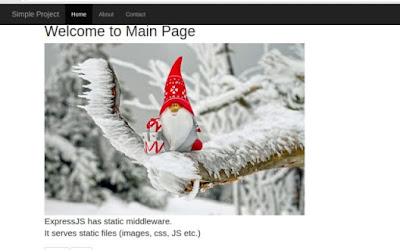NodeJS: Develop a Static File Server
NodeJS: Develop a Static File Server
Tutorial 1: NodeJS: An Asynchronous WorldTutorial 2: Express: Middleware or more...
Tutorial 3: Understanding Routing in Express
Tutorial 4: Develop a Static File Server
Tutorial 5: Using HTTPS with Express
Tutorial 6: Develop a JSON API server
Tutorial 7: Use Templates and Views with Express
Tutorial 8: Integrating MongoDB
Tutorial 9: Testing Express Applications
Tutorial 10: Securing Express
Let us try to build a static page using BootStrap framework (http://getbootstrap.com). To install BootStrap, you can use npm command i.e.
$ npm install bootstrap@3
You can check the Bootstrap structure it contains files under 'dist' folder which can be distributed.
Copy the folders of 'dist' of make soft-link of these sub-folders to your expressJS web-site folder.
Create a folder named “images”. Also, install jquery
For example, the following commands create short links of bootstrap and jquery folders inside 'public' folder.
$mkdir public
$cd ./public
$mkdir images
$ln -s ../node_modules/bootstrap/dist/css/ .
$ln -s ../node_modules/bootstrap/dist/fonts/ .
$ln -s ../node_modules/bootstrap/dist/js/ .
$npm install jquery@1.12.4
$ln -s ../node_modules/jquery/dist/ .
Create a simple web page using BootStrap framework, you can check the basic templates at BootStrap Starter's Templates. Also, copy an image in 'public/image' folder.
<-- code--="" html="">
<!DOCTYPE html> <html lang="en"> <head> <meta charset="utf-8"> <meta http-equiv="X-UA-Compatible" content="IE=edge"> <meta name="viewport" content="width=device-width, initial-scale=1"> <!-- The above 3 meta tags *must* come first in the head; any other head content must come *after* these tags --> <title>Welcome Page</title> <!-- Bootstrap core CSS --> <link href="./css/bootstrap.min.css" rel="stylesheet"> </head> <body> <nav class="navbar navbar-inverse navbar-fixed-top"> <div class="container"> <div class="navbar-header"> <button type="button" class="navbar-toggle collapsed" data-toggle="collapse" data-target="#navbar" aria-expanded="false" aria-controls="navbar"> <span class="sr-only">Toggle navigation</span> <span class="icon-bar"></span> <span class="icon-bar"></span> <span class="icon-bar"></span> </button> <a class="navbar-brand" href="#">Simple Project</a> </div> <div id="navbar" class="collapse navbar-collapse"> <ul class="nav navbar-nav"> <li class="active"><a href="#">Home</a></li> <li><a href="#about">About</a></li> <li><a href="#contact">Contact</a></li> </ul> </div><!--/.nav-collapse --> </div> </nav> <div class="container"> <div style="margin-top: 100px;margin-bottom: 100px;margin-right: 150px;margin-left: 80px;"> <h1>Welcome to Main Page</h1> <img src="./images/santa.jpg" /> <p class="lead">ExpressJS has static middleware.<br> It serves static files (images, css, JS etc.)</p> <a class="btn btn-default" href="#" role="button">Login</a> <a class="btn btn-default" href="#" role="button">Sign</a> </div> </div><!-- /.container --> <!-- Bootstrap core JavaScript ================================================== --> <!-- Placed at the end of the document so the pages load faster --> <script src="./dist/jquery.min.js"></script> <script src="./js/bootstrap.min.js"></script> </body> </html>
The following snippet (ex11.js) will prepare our static web server.
var express = require('express'); var app = express(); app.use(express.static(__dirname + '/public')); app.use(function(req, res) { res.status(404); res.send("File not found!"); }); app.listen(8000, function() { console.log("Express server listeing on port 8000..."); });
Open browser and access http://localhost:8000/, you can see the main page is served.








No comments
Post a Comment